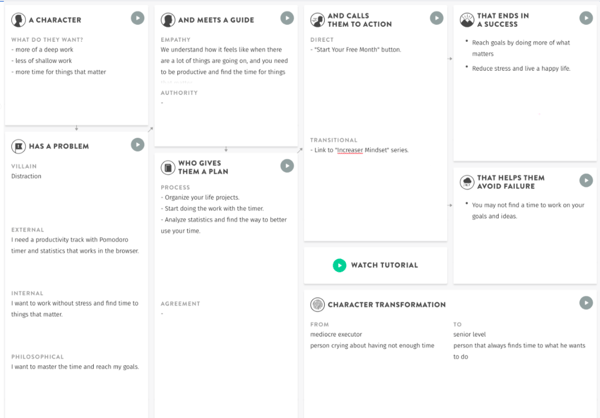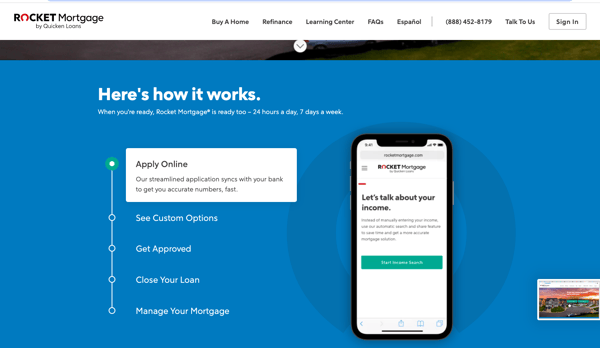Brand messages often describe what your brand has to offer in a way that is persuasive, motivational, inspirational, and memorable. But if your brand's messaging is convoluted, it could cause your audience to become disengaged and they will forget key details about your brand.
The StoryBrand framework can help you solve your brand messaging problems by laying down the necessary steps that allow you to leverage story and engage your audience.
What Is the StoryBrand Framework?
The StoryBrand framework is a popular seven-part marketing messaging tool designed to clarify how companies present their products and services. The concept of the framework is to leverage the power of story to relay a business’ brand message in order to connect with their audience on an emotional level
According to Donald Miller, author of the book Building a StoryBrand, the best way to evoke emotion using the framework is to adapt your marketing messages to the hero’s journey.
The goal of this framework is to help professionals and businesses communicate a simplified brand message that is story-driven and places the customer at the most important and central part of everything.
After you learn about the StoryBrand framework, you can begin transforming your brand's messaging using the seven principles of building a StoryBrand.
Building a StoryBrand: A Summary of 7 Principles
Here is a brief overview of the seven principles or steps in the StoryBrand framework:
- A character: Your customer is the hero.
- Has a problem: As a successful company, you should attend to your customers’ inner problems.
- And meets a guide: The customers search for a guide to help them with their frustrations.
- Who has a plan: Customers will trust a guide who has a plan.
- And calls them to action: Customers are confronted with a choice to take action.
- That helps them avoid failure: Each party involved tries to avoid a tragic ending as best they can.
- And ends in success: Your customers understand how the product or service your business is offering can successfully improve their lives.
Now that you have a basic overview of the seven step StoryBrand process, here is a more in-depth summary of each principle.
1. A Character
Each story begins with a character who wants something. The character in your story is your customer. Before you can market to them in an effective way, you have to identify who you are trying to assist and what change you want to happen.
This means you need to know who to target and commit to trying to help them with their problems.
The character is the center or hero of the story, not your business. Your marketing messages should seek to invite the customer into the story. Figure out what your customer wants as it relates to your brand and discover if your company is known for one thing it offers. Once you find your primary offering, you must form a simple summary in a few words.
The goal is to make sure your customer or “character” doesn’t have to think too hard – if they do, they may end up exiting your site and bouncing to another website, forgetting your marketing message entirely.
2. Has A Problem
A customer buys from a brand to solve some problem that is frustrating them.
It is your job as a marketer to identify that problem and put a message out that lets people know you can solve that issue. This involves having a clear and distinct message that connects with your audience.
A message that is clear, demonstrates how it can solve your customer’s problem, and connects to them in some way is more likely to be remembered by people and capture their interest.
3. And Meets A Guide
Customers don’t need your business to be the hero that saves them; they need a guide who can lead them toward a solution.
For example, in a classic hero’s journey story, your business would be:
- Yoda, not Luke Skywalker from Star Wars
- Dumbledore, not Harry Potter from the Harry Potter series
- Haymitch, not Katniss Everdeen from the Hunger Games series
Once you understand your position in your character’s story, you will be prompted to change your messaging to reflect your prospects' needs.
Your customers want you to present them with your products and services as weapons or tools that help them along their journey to solve their problems so they can live happily ever after.
4. Who Provides Them With a Plan
Although you may have answered your prospects' questions up to here, it is not the time to ask for the sale. There is still a gap between where they are and where they are trying to go. They want to make sure whatever product or service they purchase from you is not a waste of money.
The best way to overcome your prospects' hesitations is to provide them with a plan.
For example, a leasing consultant might tell a prospect over the phone that they have a great apartment available that fits all of the prospect’s needs. They have an easy process you can follow to start the rental process.
- Set an appointment to meet so you can tour your future home.
- Determine which unit is best for you and fits your budget and needs.
- You get a great apartment that fits X needs and is within your budget once your application is approved. The leasing consultant can help you with the entire move-in process and help you have a positive living experience for the duration of your lease.
When you provide your prospects and customers with a plan, you assist them with overcoming the obstacles to their success. A good question to ask yourself is, “Do I have a simple plan that makes it easy for customers to conduct business with me?”
5. And Calls Them to Action
This step requires you to either ask for the sale or to ask for their information in exchange for something of value (known as a lead magnet or content offer) that supports the prospect until they convert.
Your customers often follow your lead since you are their guide. This means you must call or challenge them to buy your products or services.
The challenge or call to action should be very clear so the prospect knows what you want them to do.Call to action buttons on your website should contain action verbs, be easily visible, and positioned somewhere on your site that makes sense.
6. That Helps Them Avoid Failure
In a typical story, heroes often follow their call to action because something is at stake. For example, Katniss Everdeen wants to save her sister so she volunteers for the Hunger Games. If Katniss’ sister wasn't selected to be a part of the Hunger Games, Katniss would have not volunteered.
Most characters do not want to engage in what happens in a story. Instead, they are compelled to. The reason they are compelled to engage in the action is to avoid some uncertain tragic ending, such as Prim being too young and weak to fight in the Hunger Games and dying.
Your customer also wants to avoid failure or tragedy. That means you must communicate a clear message about the negative consequences that may come from their refusal to purchase your product or service. Let them know what’s at stake or what they will miss out on if they don’t take action now.
7. And Ends in Success
It is essential to provide your prospects with a positive idea of what their lives will be like once they have your product or use your services. Tell your customers what their “happily ever after” looks like.
For example, Katniss didn’t believe she could win the Hunger Games but several other characters believed she could like Haymitch and Peeta. Her happily ever after was returning to District 12 alive so she could care for and protect her sister and give her the life she deserved.
The way you let your prospects know what their success looks like is by providing them with visually appealing website images and thoughtful sales-copy. Show them what their life could be like living in your apartment community, with a cleaner kitchen, with automated sales software, or whatever ideal results comes from using your products or services.
You can make people believe in a happy ending as long as you give them one to steer toward.
Inspiring StoryBrand Website Examples That Follow a BrandScript
A BrandScript is a key message that sets the foundation for the messages you should aim to repeat many times throughout your marketing. It's crafted by brands who follow the seven-step process and answer the questions each step poses.
They use their BrandScript on their website and throughout several other marketing channels to convey their simple and meaningful message. Here is one example from Increaser, a productivity app, that is planned out using a BrandScript template:

Each section of your BrandScript template includes a writing exercise where you add descriptions and details about the principle. Here's a breakdown of what each section consists of:
- A Character: Describe what your ideal customers want.
- Has a Problem: List out problems you solve. These problems are broken down into:
- Villain: Personify a root cause to your customers' problems.
- External Problems: A tangible issue your customers struggle with.
- Internal Problems: This is usually an emotion (frustration or doubt) attached to their external problem.
- Philosophical Problems: The bigger "why" that ties to deeper meaning.
- And Meets a Guide: Make a statement that expresses empathy, and describe how your brand can demonstrate competency in helping your audience solve their problem.
- Who Gives Them a Plan: List three to four steps your customers can take that would lead them to a sale, then list the agreements you make with your customers to alleviate their fears of buying your products or services.
- And Calls Them to Action: Include a list of direct CTAs and other CTAs you use to on-ramp customers.
- That Ends in a Success: List positive changes customers experience when they use your products or services.
- That Helps Them Avoid Failure: List negative consequences of not using your products or services.
- Character Transformation: Describe how customers feel about themselves before they use your products or services, then detail who they become once they close a your customer.
To give you a better idea of how a BrandScript can be applied to your business, here are three inspiring websites that use the StoryBrand framework:
Dressember
Dressember, a non-profit organization that advocates to end human trafficking, adopts a brand message that is translated simply and effortlessly on their website. They explain what they do and who they do it for in just a few words.
Their character is a donor or advocate. The problem is human trafficking or slavery. The company is the guide that educates its character about slavery around the world. The plan is to end slavery using its customers' donations or advocacy as shown with the CTA buttons in the top right-hand corner of the page.
The images below represent the last two steps of the seven principles. The first image on the left provides a couple of meaningful sentences that outline human trafficking as a real issue that "may exist right next door to you."

The other images show groups of happy people who may have been helped by Dressember donations or advocacy, thereby displaying the success customers could have if they become donors or advocates. By giving someone else a happy ending, the customer also gets a happy ending knowing that they helped accomplish that goal.
Rocket Mortgage
Rocket Mortgage, acting as the guide, clearly defines what they do and who its character is.
The character for Rocket Mortgage is a prospective or current home owner. The problem the character has is needing a mortgage to purchase a home or refinancing a home they already own. The call to action buttons are visible and personalized for each character type.

The plan is outlined in the image below from the company's website. It tells customers they can apply online, see custom options, get approved, close a loan, and manage a mortgage.

World Housing
World Housing has a clear homepage that lets their character know what they do in just one sentence. The character is the donor for this non-profit's cause. The tagline translates failure and success simultaneously, and the short video underneath the tagline evokes an emotional response from viewers and provides them with a plan.
The call to action on the World Housing webpage is distinct, and it urges site visitors to "Donate Now." The success or happy ending would be making children and others happy, like the child in the picture who is smiling, by contributing to housing initiatives for them.

Simplify Your Messaging Strategy Now
The brand story you develop when following the StoryBrand framework can help your business create a memorable experience for your customers that drives growth for the long term.
By focusing on simplifying your marketing and sales copy and honing in on what your customers want to hear, you're well equipped to generate more qualified leads and close more happy customers.
Simply put, applying this framework helps you and your customers find a "happily ever after."



Erika Giles
Erika is a Marketing Copywriter at Bluleadz. She is a huge fan of houseplants and podcasts about conspiracy theories. She spends most of her free time reading, writing, and enjoying the outdoors.